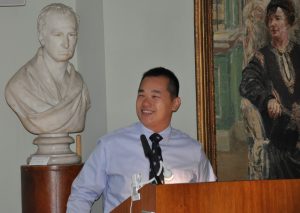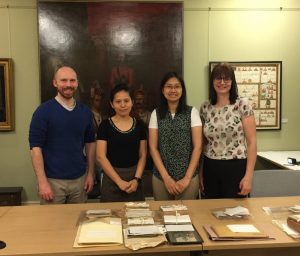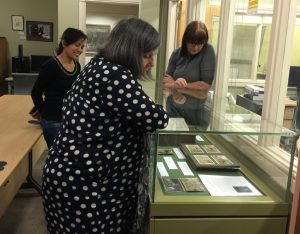Bibles, Mulberries, Cambodia, and the Journal of the Royal Asiatic Society
Last week saw two very different lectures from Dr George Mak and Dr Peter Coles looking at the history of the Mandarin Union version of the Bible and of Mulberry trees. More of that below, but first:
A Message from the Publications Committee
Fellows of our Society and readers of our blog will already be aware that the Journal’s former editor Professor David Morgan died in October. He was editor for many years and instrumental in setting up our current publishing partnership with Cambridge University Press. Up until October he continued to contribute, by writing reviews, sitting on committees and refereeing articles. He is greatly missed by all in the editorial team. At our Publications Committee it was decided that the Journal should publish an obituary to him in the first part of Vol 30. This, in conjunction with current civil unrest in Hong Kong, will result in a delay of about 2 months to the scheduled publication date.
~~~~~~~~~~~~
On Tuesday 10 December, the Society was delighted to welcome back Dr George Mak (Hong Kong Baptist University), who delivered a lecture on “The Mandarin Union Version After One Hundred Years: A Reflection on the History and Impact of a Classic Chinese Biblical Translation”. George presented the history of Bible translation into Chinese; explained how different Protestant denominations collaborated over the Mandarin Union Version; and discussed its importance in the history of the written vernacular, as well as its broader cultural and literary impact. The lecture was followed by an engaging Q&A, and a reception.

Dr Peter Coles, co-founder of Morus Londinium, gave a lecture entitled Silk, Syrup and Shade: 4000 years of Mulberry Migrations to celebrate the launch of his book Mulberry (Reaktion Books, 2019) on Thursday, 12th of December. He traced the migration of the mulberry tree from its origins in China and Central Asia to Europe, with the associated development of silk production. He also discussed the surviving mulberry trees found in the grounds of old monasteries and stately homes in Britain which can be located on the interactive map on the Morus Londinium website www.moruslondinium.org. His interesting and wide-ranging talk was enjoyed by the audience who attended on a very wet and inclement night against a background of election fever.

~~~~~~~~~~~~
Last week also saw the completion of the placement of Sonetra Seng, an intern on the Southeast Asia Art Academic Programme (SAAAP) at SOAS, University of London. Here she writes about her experience working at the Society:
“It was a great pleasure for me to be able to spend 10 weeks (100 hours) in autumn 2019 as an intern at the Royal Asiatic Society (RAS) in London under the generous support from the Southeast Asia Art Academic Programme (SAAAP) at SOAS, University of London. My main focus was to catalogue and repackage the photograph and glass slide collections of Horace Geoffrey Quaritch Wales (1900-1981) during his time in Southeast Asia between 1926-1950s
I am grateful to Edward Weech (librarian) and Nancy Charley (archivist) who generously provided the training on cataloguing, packing and labelling techniques and for their continuous support and encouragement.

The photograph and glass slide collections that I’ve been working on (together with another intern, Mrs. Vuthyneath Khut) mainly include those of Quaritch Wales’s various trips to Southeast Asia. During his early years, he travelled to Siam, Cambodia, Vietnam, Malaysia, Indonesia and India. His photos were mostly about art history, ancient and pre-modern architectures, landscape, archaeological excavation and everyday life in Southeast Asia, for instance photos of Buddhist temples in East Java, Buddhist monasteries, Hindu temples and art objects in Thailand, Cambodia, Champ, Malaysia etc. The photographs were repackaged and catalogued while the glass slides need to be scanned and repackaged in individual envelopes using photograph preservation paper or cellulose envelopes to prolong their lives and prevent them from further damage.

Beside cataloguing and repacking the collections, I was pleased to accept the offer to install an exhibition in the Reading Room of the Society (with my above mentioned colleague). According to the limited space of the exhibition case (one vitrine of 1.2m x 0.60 m), we decided to choose Quaritch Wales collection about Cambodia as the theme of our display. Another core reason to select this particular collection was also of our intention to highlight the existence of Cambodian resources in the UK, which are normally not so abundant. There are around 300 photographs about Cambodia including two albums, some loose photographs and postcards. His main interest about this country was about its rich cultural heritage (Buddhist monasteries, temples and statues), nature and everyday life of the local inhabitants. Additionally, what drove us to choose this fascinating collection was his hand-written journal of his trip which included 42 pages about Cambodia with some illustrations of Angkor Wat temple, and hand drawn maps of Cambodia and the Angkor Thom complex.

Beyond the Cambodia’s collection I was very interested in the Java collection where Quaritch Wales took numerous photos of the reliefs from Borobudur and Prambanang temples in Yogyakarta, Indonesia. I was lucky enough to visit the temples during my trip to attend a textiles symposium in East Java during my internship and to see the temples and their wonderful reliefs after working on their longtime old photographs.

To summarize, it was a real honor to be able to work on this Quaritch Wales collection and it was also a great experience for me to be trained in a UK based institution which particularly specialises in Asia, and especially on the collection connected to Hindu-Buddhism in pre-modern Southeast Asia which relates to my research area and interest. I was delighted to be able to practice the skills that I learnt from at least four modules I took in SOAS during my MA last year: Curating Culture, Southeast Asia’s Art History, Hindu and Buddhism Arts of the Maritime Silk Road. and Photography and the Images in Africa, which I could apply here in the Cambodian and Southeast Asian context. Last but not least, I hope I will be able to use the skill I learnt to teach students back home in Cambodia and to share with colleagues who work in museums and archives.”
~~~~~~~~~~~~
As another busy year draws to the close, we would like to thank all our volunteers and interns. They make such a difference in helping to look after our Collections and make them more accessible to all our researchers. And we would also like to thank all of you who take the time to read this blog and to wish you all a very happy Christmas season and to hope that 2020 will be a year of peace and happiness for you. The Royal Asiatic Society will close for the Christmas period on Friday 20 December and re-open again on Monday 6 January with the Reading Room opening on Tuesday 7 January. We look forward to more challenges and successes with the Collections, and within the Society as a whole, in the coming year.
